Ask A Researcher
September 2015
Growing Older in North Dakota

Kendra Erickson-Dockter, research specialist with the Center for Social Research and the North Dakota Compass project director, leads the design and operation of the ND Compass project. Her research efforts have involved a wide range of topics, from early childhood and aging to health and disadvantaged populations. In addition to her duties at the Center, Kendra is also completing a doctorate in Human Development, with an emphasis in Applied Gerontology, at North Dakota State University.
For many years, the “graying” of North Dakota appeared inevitable due to the outmigration of young adults, improvements in life expectancy, and the aging of the baby boom generation (those born from 1946 to 1964). However, recent media headlines paint a much different picture of North Dakota’s population overall. The headlines are correct - North Dakota overall is no longer seeing a “graying” effect, but rather a reinvigoration of younger population. Propelled by the energy development in western North Dakota and other economic opportunities throughout the state, more young people are now moving to North Dakota. This, coupled with an increase in total births, has resulted in significant growth for the state over the past decade. For three years in a row, North Dakota has had the fastest growing population among states in the nation.

While this population growth is being led by those ages 20 to 64, the older adult population has and will likely continue to grow throughout North Dakota. The leading age of the baby boom has already reached age 65, and boomers will continue to enter the ranks of the 65 plus age group through 2030.

What does the older adult population look like in North Dakota historically and today?
Historically, the number of older adults (ages 65 and older) as a proportion of the overall population has remained relatively stable.

Between 1990 and 2014, the older adult population accounted for about 14% of the overall population, with projections suggesting a slight increase to 15.8% by 2020 and 17.6% by 2025. Although as a percent of the total population this age group does not see big changes because of the influx of younger population in the state, the number of older adults is increasing and will likely continue to increase.
For example, the older adult population in North Dakota was 80,445 in 1980, 97,477 in 2010, and 104,998 in 2014. The population projections indicate that by 2020 the older adult population will be 127,318 and by 2025 it is projected to be 148,060. If we calculate the growth in population from 2010 (the last Census) to 2025, the number of older adults in North Dakota is expected to grow by more than 50% from 97,477 to 148,060 older adults.

This increase will affect our state’s workforce, health and human services agencies, and beyond. Thus, from a decision-making perspective it is important to consider the actual change in numbers, the proportional change, as well as other breakdowns such as age subgroups and geography.
Is the 85 year old and older population following the growth forecast of the age 65 and older population?
When examining the historical data there was a large increase in the number of the oldest-old (85 year old and older) population from 1980 to 2000. This population saw an 81% increase in total numbers from 8,140 in 1980 to 14,726 in 2000. The most recent data shows that in 2014, this age group accounted for 2.4% of the population, which equated to 17,959 older adults in North Dakota. When looking at the change in population from 2000 to 2014, this population increased by 22%, which is a much smaller increase than the previous time span of 1980-2000.

Population projections support that the 85 years and older population will remain relatively similar in the proportion of the population and in total numbers through 2025.
Reasons for the leveling off may include the fact that the baby boom generation would not have moved into this age group by 2025 to sustain the growth as well as health and behavioral factors.
Do older adult populations differ by county in North Dakota?
Absolutely! The age of a county reflects the interaction between birth rates, life expectancy, and migration. While some counties are getting younger especially due to younger people moving into the state, others continue to experience no change or to see an increase in the proportion of older adults. In 10 mostly rural counties, at least one in four residents were older adults (25% or higher). McIntosh and Sheridan counties led this group with nearly one in three residents being older adults in 2013. On the other end, 13 counties (metro, reservation, and energy development areas) are much younger, with fewer than 15% of residents being older adults.

Taking into consideration regional differences and the trends affecting the older population will help policy makers, health and human services, and community leaders more effectively plan for the needs, challenges and opportunities impacting older residents in North Dakota.
